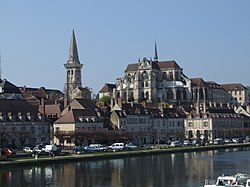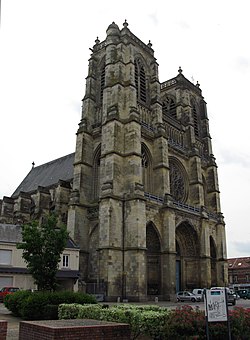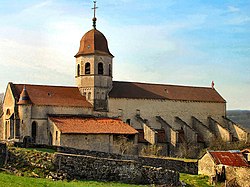A
- L'Absie Abbey (Abbaye de l'Absie-en-Gâtine), Diocese of La Rochelle (L'Absie-en-Gâtine, Deux-Sèvres)
- Abbey of L'Absie-en-Brignon, see Abbey of La Sie
- Ahun Abbey (Abbaye Saint-Étienne d'Ahun), monks, Diocese of Limoges (Moutier-d'Ahun, Creuse)
- Ainay Abbey (Abbaye Saint-Martin d'Ainay), monks, Diocese of Lyon (Ainay, Lyon) [2]
- Alet Abbey (Abbaye d'Alet or Abbaye Sainte-Marie d'Alet), monks (Alet-les-Bains, Aude) [3]
- Les Alleuds Abbey (Abbaye des Alleuds), monks, Diocese of Poitiers (Les Alleuds, Maine-et-Loire)
- Les Allois Abbey (Abbaye des Allois), nuns, Diocese of Limoges (La Geneytouse, Haute-Vienne)
- Almenêches Abbey (Abbaye Notre-Dame d'Almenêches), nuns, Diocese of Séez (transferred to Argentan in 1736) (Almenêches, Orne)
- Altorf Abbey (Abbaye d'Altorf), monks, Diocese of Strasbourg (Altorf, Bas-Rhin)
- Ambronay Abbey otherwise Ambournay Abbey (Abbaye Notre-Dame d'Ambronay or d'Ambournay), monks, Diocese of Lyon (803-1787) (Ambronay, Ain) [4]
- Anchin Abbey (Abbaye d'Anchin), monks, Diocese of Arras (Pecquencourt, Nord)
- Andecy Abbey (Abbaye Notre-Dame d'Andecy), nuns, Diocese of Châlons-sur-Marne (Baye, Marne)
- Andernes Abbey (Abbaye d'Andernes), monks, Diocese of Boulogne-sur-Mer (Andernes near Guînes, Pas-de-Calais)
- Andlau Abbey (Abbaye d'Andlau), [5] nuns, Diocese of Strasbourg (Andlau, Bas-Rhin)
- Angers (Maine-et-Loire), Diocese of Angers:
- Abbaye Notre-Dame du Ronceray d'Angers, see Ronceray
- Abbey of St Aubin, Angers (Abbaye Saint-Aubin d'Angers), monks, (966-?)
- Abbey of St Nicholas, Angers (Abbaye Saint-Nicolas d'Angers) (1020-?)
- Abbey of St. Sergius, Angers (Abbaye Saint-Serge d'Angers), monks
- Abbey of Saint-Pierre-les-Nonnains
- Angoulême (Charente), Diocese of Angoulême:
- Abbey of St Ausonius, Angoulême (Abbaye Saint-Ausone d'Angoulême), nuns
- Abbey of St Cybard, Angoulême (Abbaye Saint-Cybard d'Angoulême), monks
- Aniane Abbey (Abbaye Saint-Sauveur d'Aniane), monks, Diocese of Maguelonne, later Diocese of Montpellier (782-?) (Aniane, Hérault)
- Arcisses Abbey (Abbaye d'Arcisses), nuns, Diocese of Chartres (Arcisses in Brunelles, Eure-et-Loir)
- Argentan Abbey (Abbaye Notre-Dame d'Argentan), nuns (transferred from Almenêches 1736; dispersed during the French Revolution; reassembled at Vimoutiers in 1822; returned to Argentan in 1830 and 1958; refugees in Sées from 1944 to 1958) (Argentan, Orne) [6]
- Argenteuil Abbey (Abbaye Notre-Dame d'Argenteuil), nuns (Argenteuil, Val-d'Oise)
- Abbey of St Caesarius, Arles (Abbaye Saint-Césaire d'Arles), nuns, Diocese of Arles (Arles, Bouches-du-Rhône)
- Abbey of St Mary, Arles-sur-Tech (Abbaye Sainte-Marie d'Arles-sur-Tech), monks, Diocese of Perpignan (Arles-sur-Tech, Pyrénées-Orientales)
- Arpajon Abbey (Abbaye Notre-Dame d'Arpajon), nuns, Diocese of Vabres although physically located within the territory of the Diocese of Rodez (Arpajon-sur-Cère, Cantal)
- Abbey of St Vaast, Arras (Abbaye Saint-Waast d'Arras), monks, Diocese of Arras (Arras, Pas-de-Calais)
- Artecelle Abbey, see La Celle Abbey
- Asnières Abbey (Abbaye Notre-Dame d'Asnières or Asnières-Bellay), monks, Diocese of Angers (1129-?) (Cizay-la-Madeleine, Maine-et-Loire) [7]
- Auchy Abbey otherwise Aumale Abbey (Abbaye d'Auchy or Saint-Martin d'Auchy or d'Aumale), monks, Diocese of Rouen (Aumale, Seine-Maritime

- Auchy Abbey (Abbaye d'Auchy-les-Moines), monks, Diocese of Boulogne-sur-Mer (Auchy-lès-Hesdin, formerly known as Auchy-les-Moines, Pas-de-Calais)
- Aumale Abbey, see Auchy Abbey
- Aurillac Abbey (Abbaye d'Aurillac), monks, Diocese of Clermont (about 896-1561) (Aurillac, Cantal)
- Autun (Saône-et-Loire), Diocese of Autun:
- Abbey of St. Andoche, Autun (Abbaye Saint-Andoche d'Autun), nuns
- Abbey of Saint-Jean-le-Grand (Abbaye Saint-Jean-le-Grand d'Autun), nuns
- Abbey of St. Martin, Autun (Abbaye de Saint-Martin d'Autun), monks
- Abbey of St. Symphorian, Autun (Abbaye de Saint-Symphorien d'Autun), monks
- Auxerre (Yonne), Diocese of Auxerre:
- Abbey of Saint-Germain d'Auxerre (Abbaye Saint-Germain d'Auxerre), monks [8]
- Abbey of St. Marianus, Auxerre (Abbaye Saint-Marien d'Auxerre), monks
- Avenay Abbey (Abbaye d'Avenay), nuns, Diocese of Reims (Avenay-Val-d'Or, Marne)
- Avesnes Abbey (Abbaye Notre-Dame d'Avesnes), nuns, Diocese of Arras (Avesnes, Pas-de-Calais)
- Avignon (Vaucluse), Diocese of Avignon:
- Abbey of St Andrew, Avignon (Abbaye de Saint-André-lès-Avignon), monks, attributed to the Diocese of Orange
- Abbey of St Laurence, Avignon (Abbaye Saint-Laurent d'Avignon), nuns


























